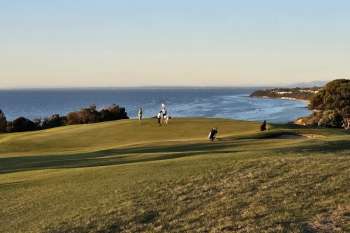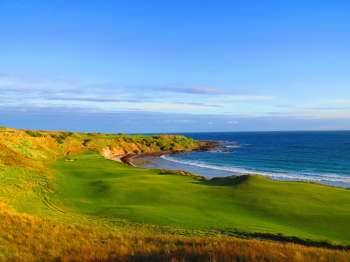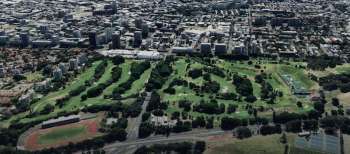Australia's Top 100 Golf Courses - 2012
To view the 2012 ranking of Australia's Top 100 Golf Courses - click here
Australian golf has a new number 1. For the first time since Australian Golf Digest started publishing a Top 100 ranking of golf courses in the 1980s, the West Course at Royal Melbourne has topped our biennial list. Until 2010 every previous ranking compiled by this magazine had featured the Composite Course at Royal Melbourne in top spot. Last time it was the sublime Kingston Heath that instead took first place. While the accolade was fully deserved, it was an honour that even the most passionate Kingston Heath member must have accepted was only temporary.
Royal Melbourne’s fall from grace two years ago can be attributed to a couple of key factors. One was our decision to finally split Composite Course rankings and instead judge each course on its own individual merits. The other was an unprecedented period of drought and poor course conditioning. Throughout much of the last ranking period Royal looked anything but regal and, as we wrote at the time, the overwhelming view of our panel was that it couldn’t be held up as the country’s ideal course while in such a neglected state.
Fast-forward two years and thankfully things have now changed. The combination of a better quality, and more secure, water supply has allowed the club to focus on improving its turf and maintaining playing areas at a standard one would expect from such a prestigious institution. Course superintendent Richard Forsyth (Australian Golf Digest Superintendent of the year 2011) has worked wonders at Royal Melbourne, particularly around the greens where a renewed emphasis on firmness has once again allowed the genius architecture to shine through. As the Presidents Cup showed clearly, when kept in firm and bouncy condition Royal Melbourne is our most intriguing test of golf. It is appropriate, therefore, that the best course architecturally in Australia has now assumed its rightful place at the top of our list.
Dropping back to number 2 may be seen as a demotion for Kingston Heath, but our panel actually awarded the course a higher points average (see scoring criteria somewhere?) than in 2010, which further highlights that the previous ranking was more about the fall of the West than the rise of the Heath. While both of Royal Melbourne’s courses improved their conditioning scores considerably, Kingston Heath remained the best-maintained classic course in the country and continues to score well in other key criteria.
Perhaps the only layout that consistently out-grooms Kingston Heath is the ultra-private Ellerston golf course in New South Wales’ upper Hunter Valley, which this year came in at number 3. Ellerston’s inclusion always raises the ire of those who feel that exclusive courses should be ignored by our panel, and a jump from 5 to 3 is sure to fuel dissent even further. Our aim with this list, quite simply, is to rank the best golf courses in Australia, regardless of access, membership structure, cost or location. To that end Ellerston, as a course in Australia, is worthy of consideration and this time around we were able to get 14 judges up to see the Bob Harrison-Greg Norman designed masterpiece. Their enthusiasm for the layout was considerable, with notable improvements made since the last group visit back in 2007. Australian Golf Digest editor Steve Keipert noted that, ‘Ellerston continues to improve, subtly but surely. The course hasn't been overhauled since it first opened a decade ago, yet the ongoing refinements have been effective. Judges who saw the course for a second or third time over that time span noticed its progress.' Interestingly, of the 14 judges who visited Ellerston last year, eight scored it the highest or equal highest in the country. The simple reality is that the course is very good, and other ranking lists that ignore it are incomplete.
Making the highest debut since Ellerston landed in 4th place back in 2004, the brilliant Lost Farm course in Tasmania stormed straight into our Top 10 and past a host of established stars into 6thposition. What impressed our judges about Lost Farm were its big dunes, its raw beauty and its broad, strategic fairways and artistically contoured green complexes. By any definition this is world-class golf and its best holes, such as the 5th and 14th, are among the finest in Australia.
A number of panellists commented that when the fescue surfaces mature at Lost Farm the playing experience will improve even more. The question, therefore, for 2014 and beyond, is whether Lost Farm will ever upstage and outrank its older sibling Barnbougle Dunes, which this year holds onto 4th position on the list. Barnbougle continues to impress our judging panel, and despite its somewhat remote location still manages to draw visitors from all corners of the country. We have 45 judges in total on the Australian Golf Digest panel (from every state) and were pleased that 35 managed to make it to Barnbougle during our two year ranking window. A number regard Barnbougle Dunes as Australia’s best golf course, while others are of the opinion that Lost Farm is an even better track. The title of top dog in Tasmania is definitely up for grabs in two years time.
The biggest surprise within the rest of our Top 10 is the fall of New South Wales, which recently completed a full greens resurfacing program that interrupted play for many months and perhaps explains its drop from 2 to 5. Reshaping work was also carried out on the 3rd and 4th greens, as well as the 4th fairway, which our panel will assess in the lead-up to the next ranking. They will also take a fresh look at perennial Sandbelt favourite Metropolitan, which dropped from 7th to cling onto a place inside the Top 10 by the barest of margins. Apart from the rebuilding of the problematic par three 13th, Metropolitan has changed little in the past two years and was only relegated because of the inclusion of Lost Farm and noticeable on course improvements at Victoria (9th) and on the East Course at Royal Melbourne (8th).
The other elite golf club to suffer as a result of improvements elsewhere is Royal Adelaide (9 to 13), which drops out of the Top 10 for the first time in recent memory. We have devoted feature articles in this magazine to the mess at Royal Adelaide, and clearly the time has come for the club to act decisively and arrest its present slide. The priority at board level seems to be on ‘fixing’ Michael Clayton’s contentious 17th hole, which seems a short-sighted objective given we won’t really know how out-of-character the hole is until the club determines what the character of the rest of the course should be. The description of Royal Adelaide last ranking as ‘tired and dysfunctional’ seems even more apt this time around.
Leapfrogging Royal Adelaide into 11th and 12th spots on the list are Lake Karrinyup in Western Australia, and the Robert Trent Jones Jr designed Old Course at the National Golf Club in Victoria. Both feature surprisingly high on the list and are much loved by many on our panel. National Old is one of the more polarising courses in the country, with our judges scoring it as high as 47.5 (out of 50) and as low as 32. Another layout with wildly varying scores is The Australian Golf Club in Sydney, which drops from 11th spot down to 17th. The Australian is popular among those who believe that difficulty is a major factor in determining the quality of a golf course. This is still a strict test of golf, but the club accepts the need for rejuvenation and has engaged Jack Nicklaus’s company to once again come in and try to spruce the place up. Most of their focus will be on rebuilding greens and bunkers.
Other former favourites heading in the wrong direction include Kooyonga (26 from 23), Commonwealth (31 from 24), Royal Canberra (37 from 27) and Portsea (44 from 38), which all need to address serious design and aesthetic shortcomings if they are to improve in 2014. Royal Canberra will actually be in the midst of a major redevelopment when our next list is compiled. Another old classic to fall was Royal Sydney, although its drop from 15 to 21 seems more a reflection of improvements elsewhere than any poor work done during the past two years. Those that were more fortuitous among the Top 50 include the likes of the Beach Course at Thirteenth Beach (up 5 places to 24), Brookwater (up 8 places to 25), St Andrews Beach (up 4 places to 28) and Glenelg (up five places to 40).
A larger, more active panel
In each of these instances, much of the blame (or credit) for jumps and falls can be apportioned to the physical make up of our ranking panel, which has changed considerably since our last list was produced in 2010. A major point of difference with the Australian Golf Digest rankings is that we have historically had a much larger and more active panel than rival magazines, and our focus has always been on producing a list that more properly reflects the collective views of a diverse group of judges rather than the subjective opinions of our editors.
Following the last list we turned over a third of our panel, chiefly to ensure that all judges were active and, most importantly, taking the process seriously. The new people drafted in are not only passionate about golf design and the business of course rankings, they are impartial and able to get to a lot more courses than any other panel. On average 15 judges assessed each of our Top 100 courses during the two-year ranking cycle, which enabled us to properly identify and reward any improvements made at candidate clubs, and to similarly penalise those whose standards have slipped.
The course that has clearly slipped the furthest this year is one-time Top 15’er Laguna Whitsundays, which has suffered financial hardships in recent times and fallen into an appalling state of disrepair. For the first time since it opened the course did not make the final 100. The bare bones at Laguna are still really good but the investment required to make it playable and enjoyable again is significant. Naturally we wish the resort well, and hope that relief for paying customers is just around the corner.
Another to suffer a degree of financial distress is Araluen in Western Australia (93), which managed to sneak into the Top 100 again in 2012 but will be out next time if recent trends continue. Others on the brink of missing include Alice Springs (down 19 to 89), Arundel Hills (down 17 to 98), Macquarie Links (down 15 to 99) and Royal Hobart (down 22 places to 100). Each of these courses narrowly avoided the same fate as Bunbury, Twin Waters, Yering Meadows, The Vines (Ellenbrook), Albany, North Lakes, Noosa Springs and Southern, which were all bumped from the Top 100 after appearing in 2010. The East Course at The Grange Golf Club and the West Course at Indooroopilly were also omitted this year, due to major course works currently underway at both properties. Similarly, Bonnie Doon and Manly in Sydney were not considered for inclusion as both are in the midst of redevelopment and over the past year have more closely resembled construction sites than golf courses. Bonnie Doon is the first project that the Geoff Ogilvy - Mike Clayton partnership has worked on and, given the club’s lofty expectations and its beautiful sandy base, should appear somewhere on the list next time around.
The Winners
Aside from the likes of Avondale (up 16 to 59) and Pacific Dunes (up 14 to 60) the big winners this year are the 11 new entrants. These include about the most diverse trio of new courses one could possibly imagine – a bold dunes course in Tasmania, a rugged desert layout in the West Australian outback and a gentle resort test in the tropical paradise of the Whitsunday Islands.
While the Top 10 debut of Lost Farm comes as no surprise, less was expected of the other new courses at Hamilton Island (39) and Kalgoorlie (73). Neither is built upon sand or blessed with any genuine golf undulation, but each is worthy of celebration given the tremendous obstacles overcome to complete both projects. The Graham Marsh-designed Kalgoorlie golf course was built on a dusty dumpsite that was completely parched and virtually devoid of any redeeming features when construction began. After an initial developer went broke trying to build the course, the state and city joined forces to invest the near $18 million needed to ensure its completion.
In direct contrast to the bleak, arid landscape of Kalgoorlie, the Hamilton Island Golf Club was built within the World Heritage listed Marine Park of the Whitsunday Islands. Unlike at Kalgoorlie, which had the support of an eager governmental partner, Hamilton Island was weighed down by bureaucrats and a laborious planning process and took the best part of ten years to complete. Designed by Thomson Perrett, the course is an eye-catching modern style layout built atop a rugged 400-hectare monolith known as Dent Island. The course features 360-degree views of the Whitsundays and is accessible via ferry from the main Hamilton Island marina. Both courses have some maturing to do and may well climb even higher on our list in the years ahead.
Also new in 2012 is the redeveloped Palms Course at Sanctuary Cove (77), as well as The Sands, Torquay (87), the Champions Course at Sandhurst (89) and the Creek Course at Thirteenth Beach (95), which appear for the first time after missing out on previous occasions. Sea Temple (91), Robina Woods (92), Monash (94) and Federal (96) have all returned to the Top 100 after dropping off in 2010.
While appropriate congratulations are due each of our Top 100 courses, the golf business gets more and more competitive with each passing year and the 1,400 odd layouts in Australia that missed out in 2012 will no doubt be gunning for a spot in two years time. It’s important here to note, that while more than 9 points separate our 1st and 50th courses, less than 4 points separates the rest. Those ranked in the bottom half of our list, therefore, are far from secure as the likes of Pymble, Long Reef, Cranbourne, The Cape, Yarrawonga (Murray) and Keysborough, which only narrowly missed a place in 2012, are an improvement or two away from bumping off an incumbent.
Resting on ones laurels has never been a recipe for success in the golf business, but neither has the reckless pursuit of change and ‘modernisation’. As the top 10 shows us time and time again, the best courses in Australia are neither the longest, nor the tightest nor the toughest – they are simply the best. Measured, sensible improvement can only be made by proper planning and with concise objectives in mind. To that end, we hope this ranking encourages the proper custodianship of quality golf courses in this country. If we help a deteriorating club make a crucial decision on redevelopment, or equally prevent unnecessary change elsewhere, then we will have contributed in a small, but positive, way to the game we love.
Australian Golf Digest takes the responsibility of producing this list very seriously, and we understand both the boost a favourable ranking can give a struggling membership as well as the great pain caused by a poor result.
We don’t pretend for one moment that our ranking model is completely flawless, but it is the best system in this country and our list is clearly the most influential produced by an Australian magazine.
While we would love every reader to agree wholeheartedly with the final result, in all likelihood all we have stirred, yet again, here is healthy debate, which is never a bad thing. So with a Royal at the top and a Royal at the bottom there seems a nice symmetry to the 2012 Australian Golf DigestTop 100 list, a list we hope that readers will enjoy.
To view the 2012 ranking of Australia's Top 100 Golf Courses - click here
Darius Oliver, Architecture Editor Australian Golf Digest
Back to NewsMore News
Report reveals golf's $3.3 billion contribution to Australia
AGIC report reveals total annual benefits to the Australian community, economy and environment from golf.
Cape Wickham Links – The Inside Design Story
Co-designer Darius Oliver reveals the truth behind the design of Australia’s premier modern golf course
Have your say on the future of Moore Park Golf
Golfers unite – another one of our cherished public access golf courses is under threat
Cameron John wins The National Tournament by two strokes
Victorian claims breakthrough professional victory at The National Tournament presented by BMW



